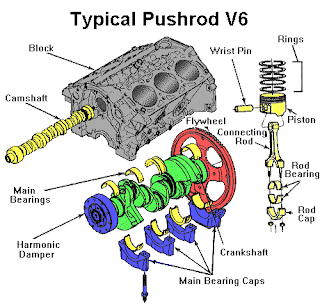Engine parts
The engine-driven accessory bearings have a successful record of operating under the harsh conditions and severe environment of the engine bay, which includes high temperatures, freezing temperatures, vibrations, drastic load changes, and exposure to water, sand and dust.Technologies applied to bearing and component materials and lubrication have resulted in products that operate with low friction, are compact, and have a long service life. These technologies contribute to improve fuel economy, high performance, and low noise.
*Careful inspection and disassembly of the valvetrain can teach you a lot. You want to look for misalignment and broken parts not only to find the problem, but to take a careful look at the non-broken cylinders to discover if damage could have been caused by problems such as bad valve adjustment, rockers slipping off the valve tips, or pushrod interference with guideplates or cylinder heads. A bent pushrod can also be telling. All we found was one bound-up exhaust spring and rocker.
What parts the engine needs is the next concern. There are two approaches to major engine repair: piecemeal and complete. The piecemeal approach is to fix only that which is broken and leave the rest alone. The underlying motivation here is primarily economic. The vehicle and/or engine may not be worth spending much money on, so only those parts that absolutely have to be replaced to keep the engine running are replaced. Other repairs can wait for the next owner or the junkyard. This approach may skimp on needed machine work and attempt to "make do" with standard sized replacement parts such as bearings, rings, pistons and valves.
The other approach is to do a complete overhaul when the engine needs major repairs. This is obviously the more expensive approach, but one that usually provides much longer-lasting results. By replacing major wear components such as the rings, pistons, bearings, oil pump, valve guides, exhaust valves, valve springs, timing chain or belt, etc., the engine is restored to "like-new" condition and should deliver another 60,000 or more miles before repairs are needed again. This approach may involve the purchase of an engine kit or buying the parts individually. It usually also requires machine work such as turning the crank, overboring the cylinders, refacing the valves and seats, resurfacing the cylinder head(s), and maybe align boring or honing an overhead cam head and/or the main bores in the block.
Of course, there are shades of gray between these two, also. An engine may need a valve job but also has some wear in the cylinders. It is a judgment call as to whether it is worth it or not to do both. In some cases, the improved compression that comes from the valve work may increase blowby into the crankcase if the rings and cylinders are worn.
The important point here is to decide what parts may be needed to fix a particular engine problem, and then to replace any additional parts that might be needed.






.gif)





